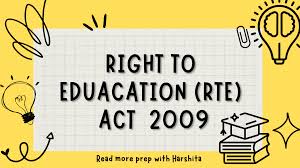Implementation of RTE and Budget Allocation for Education: A Step Towards Inclusive Education
Overview of RTE Act Implementation
The Right to Education (RTE) Act, enacted in 2009, mandates free and compulsory education for children aged 6 to 14 years in India. Despite its noble intentions, the implementation of RTE has faced significant challenges, including inadequate infrastructure, a shortage of trained teachers, and disparities in educational quality across regions. These issues have hindered the goal of providing quality education to all children, particularly those from marginalized communities. The recent government initiative to enhance the budget allocation for education aims to address these challenges, focusing on improving the overall infrastructure, teacher training, and inclusive education.
Increased Budget Allocation for Education
The government’s decision to increase the budget allocation for education is a crucial step towards strengthening the RTE Act’s implementation. This enhanced budget is expected to be directed towards building more schools, upgrading existing infrastructure, and providing adequate resources for teachers and students. Additionally, special emphasis is likely to be placed on digital education, which has gained prominence in the post-pandemic era. The increased funding also aims to reduce the urban-rural educational divide, ensuring that students in remote areas have access to the same quality of education as those in urban centers.
Focus on Teacher Training and Capacity Building
One of the critical components of the successful implementation of the RTE Act is the availability of well-trained teachers. The increased budget allocation includes provisions for extensive teacher training programs, aimed at enhancing the skills and capabilities of educators across the country. These programs will focus on modern teaching techniques, inclusive education practices, and the integration of technology in the classroom. By empowering teachers with the necessary tools and knowledge, the government seeks to improve the overall quality of education, making it more accessible and effective for all students.
Addressing Disparities in Education
Despite the progress made since the enactment of the RTE Act, significant disparities remain in the Indian education system. These disparities are particularly evident in rural areas, where access to quality education is often limited. The increased budget allocation is expected to address these disparities by focusing on improving educational infrastructure, providing scholarships and financial aid to students from economically weaker sections, and implementing targeted programs for underprivileged communities. The goal is to create an equitable education system where every child has the opportunity to succeed, regardless of their background.
The Role of Digital Education in RTE Implementation
In the wake of the COVID-19 pandemic, digital education has emerged as a critical component of the Indian education system. The increased budget allocation for education is likely to include significant investments in digital infrastructure, ensuring that students across the country have access to online learning resources. This move is expected to bridge the digital divide, enabling students in rural and remote areas to benefit from the same educational opportunities as their urban counterparts. The integration of digital education into the RTE framework is a forward-looking approach that aims to make education more inclusive and adaptable to the needs of the 21st century.

Why This News is Important
Emphasizing the Need for Quality Education
The increased budget allocation for education, coupled with the focus on the implementation of the RTE Act, underscores the government’s commitment to providing quality education for all. This move is particularly significant in a country like India, where disparities in education have long been a barrier to social and economic progress. By addressing these disparities, the government aims to create a more equitable society where every child has the opportunity to succeed.
Strengthening the Foundation of India’s Future
Education is the foundation of a nation’s future, and the government’s efforts to enhance the implementation of the RTE Act are a step in the right direction. By investing in education, the government is not only empowering the youth but also ensuring the long-term growth and development of the country. This news highlights the importance of education as a tool for social change and economic development, making it a critical topic for students preparing for government exams.
Addressing Post-Pandemic Educational Challenges
The COVID-19 pandemic has brought to light the challenges facing the Indian education system, particularly in terms of digital education and access to resources. The increased budget allocation for education aims to address these challenges, ensuring that the education system is better equipped to handle future crises. This news is important as it highlights the government’s proactive approach to education reform in the post-pandemic era.
Historical Context:
The Genesis of the Right to Education
The Right to Education (RTE) Act, passed in 2009, was a landmark legislation in India’s educational history. It was born out of the realization that education is not just a privilege but a fundamental right for every child. The act made it mandatory for the state to provide free and compulsory education to all children aged 6 to 14 years. The RTE Act was a significant step towards realizing the vision of universal education in India, aligning with the country’s commitment to international educational goals such as the Millennium Development Goals (MDGs) and later the Sustainable Development Goals (SDGs).
Challenges in Implementation
Since its inception, the RTE Act has faced several implementation challenges. These include inadequate infrastructure, teacher shortages, and disparities in the quality of education across different regions. The government’s commitment to increasing the budget allocation for education is an attempt to overcome these challenges and ensure the successful implementation of the RTE Act. This move is part of a broader effort to reform the Indian education system and make it more inclusive and accessible to all.
Key Takeaways from “Implementation of RTE and Budget Allocation for Education”
| Sr. No. | Key Takeaway |
|---|---|
| 1 | The government has increased the budget allocation for education to strengthen the implementation of the RTE Act. |
| 2 | The enhanced budget will be used to improve educational infrastructure, particularly in rural and remote areas. |
| 3 | Teacher training programs will be a significant focus, aimed at improving the quality of education. |
| 4 | The increased funding will help address disparities in education, making it more accessible and equitable. |
| 5 | Investments in digital education are expected to bridge the digital divide and enhance learning opportunities for all students. |
Important FAQs for Students from this News
1. What is the Right to Education (RTE) Act?
The Right to Education (RTE) Act is an Indian legislation enacted in 2009 that mandates free and compulsory education for all children aged 6 to 14 years. The act aims to provide quality education and improve educational infrastructure to ensure that every child has the opportunity to learn and succeed.
2. Why has the government increased the budget allocation for education?
The government has increased the budget allocation to address various challenges in the implementation of the RTE Act, such as inadequate infrastructure, teacher shortages, and disparities in educational quality. The additional funds are intended to enhance educational facilities, improve teacher training, and ensure more equitable access to education across regions.
3. What are the main areas of focus for the increased education budget?
The increased budget will focus on building and upgrading educational infrastructure, training teachers, addressing educational disparities, and investing in digital education. These efforts aim to improve the overall quality of education and ensure that all students, including those in rural and remote areas, have access to the necessary resources.
4. How does digital education play a role in the RTE Act implementation?
Digital education is a key component of the updated RTE Act implementation strategy. The increased budget includes investments in digital infrastructure to provide online learning resources, bridge the digital divide, and enhance educational opportunities for students across the country, especially in remote areas.
5. What are the expected outcomes of the increased education budget?
The expected outcomes include improved educational infrastructure, better-trained teachers, reduced educational disparities, and greater access to digital learning resources. The ultimate goal is to create a more inclusive and equitable education system where every child has the opportunity to succeed.
Some Important Current Affairs Links















